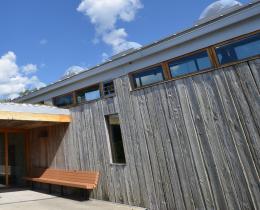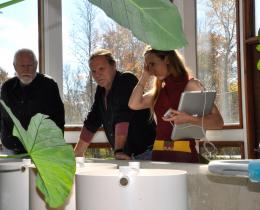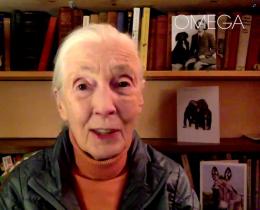In Sausalito, California, the new executive director of Project Drawdown leaned toward his laptop’s video camera, his face beaming onto a large projection screen inside Lake Theater at the Omega Institute—and from there to more than 50 satellite sites and hundreds of individuals via a live stream broadcast.
The topic at hand was reversing global warming.
“Everything that seems impossible at one moment,” Jonathan Foley said, “is not only sometimes possible, often it’s inevitable—because humans do, sometimes, rise to the challenge. I believe that we can.”
That spirit of possibility echoed inside Lake Theater and in our online community over several days of collaboration, inspiration, and connection at the Omega Center for Sustainable Living’s Drawdown Learn conference in October.
Published in 2017, Drawdown: The Most Comprehensive Plan Ever Proposed to Reverse Global Warming became a New York Times best seller, prompting hundreds of media reports, events, and editions in other countries. It was born out of the collaborative work of Project Drawdown, the nonprofit organization Foley now heads that seeks to advance a solutions-based approach to global warming.
The book was introduced to an Omega audience during the 2017 Being Fearless conference by Drawdown’s founder, visionary, and frequent Omega teacher, Paul Hawken. Hawken’s appearance in 2017 catalyzed the planning for Drawdown Learn, a gathering of educators, indigenous leaders, government officials, community organizers, and others. The goal: to develop tools, training, and curriculum to unpack the rich learning opportunities of Drawdown and chart a path forward.
“It’s time,” OCSL director Laura Weiland said, “to be big and bold in this work.”
Full Drawdown Team Makes Rare Appearance
Though individual representatives of Drawdown’s small leadership team have been traveling the world spreading its hopeful message of possibility, this weekend at Omega marked the first time the entire team had attended one event. While Foley beamed in from Drawdown’s headquarters, Hawken was joined onstage by Katharine Wilkinson, vice president of communication and engagement; Chad Frischmann, vice president and research director; and Crystal Chissell, vice president of operations and engagement.
More than 50 organizations in 17 states and at least three countries registered as satellite sites to offer collective viewings of the live stream, including 350 Vermont; the Office of Sustainability in Austin, Texas; the Hawaiian Sanctuary in Pahoa, Hawaii; the Unitarian Universalist Fellowship of Bozeman, Montana; a half-dozen libraries in Vermont; and several colleges and universities around the nation.
What followed over the next several days was a remarkable and heartening conversation between more than 200 participants representing schools, governments, businesses, community groups, and nonprofits over some 15 breakout sessions on October 20 and a self-organized, next-steps planning session on Sunday, October 21.
At the heart of all of the conversations was partnership, integration, and team building.
“We think about Drawdown,” Wilkinson said, “as gathering the collective wisdom of humanity.”
Wide Array of Organizations Leads Conversation
At Drawdown Learn, the collection of organizations was impressive. The event emerged as a collaboration between Omega, Drawdown, and core organizing partners from the Northwest Earth Institute, based in Portland, Oregon; the Putnam Northern Westchester (N.Y.) BOCES’s Center for Environmental Education; and the Cloud Institute for Sustainability Education, a New York City-based organization that has hosted its own workshops at Omega over the years.
Leading the 15 breakout sessions were representatives from the Historically Black Colleges and Universities (HBCU) Green Fund; a handful of indigenous groups, including Seeding Sovereignty and the International Indigenous Youth Council; the New York Library Association; high schools in Asheville, North Carolina, and Alameda, California; the City of Cincinnati’s Office of Environment and Sustainability; the National Oceanic and Atmospheric Administration; the American Sustainable Business Council; and others.
“Drawdown is in alignment with a lot of indigenous teachings,” said author and indigenous rights activist Sherri Mitchell during a breakout session on learning the ways of indigenous stewardship. “We have never believed we are stewards of the land. We are stewards of a way of life—in relationship to the land.”
The breakout sessions, held in three locations every hour or so, gave Omega the feel of a bustling college campus. As each session ended, participants poured from one building, their conversations ongoing and animated, and then hurried off to the next.
Young People's Panel Stirs Emotions
But perhaps the most moving moments came on the final day when six young people of diverse backgrounds took the stage to express their fears and hopes for the future. Some voiced concern about having children of their own in a world threatened by global warming.
“I wasn’t expecting this to happen up here [on stage],” Mitchell, the panel’s moderator, said as she wiped away tears.
Equally moving was their commitment.
“We are not the future,” said Birch Kinsey, a 17-year-old Buffalo-based advocate and artist. “We are the present. You need to provide young people a place at the table.”



